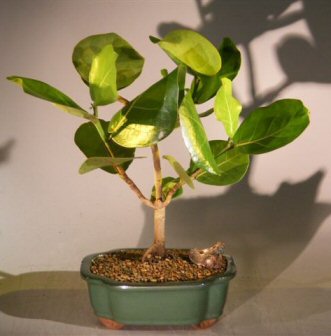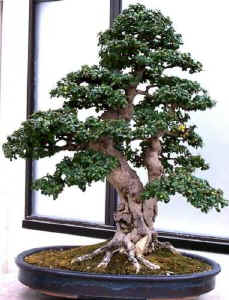But can show you a successful haul of my own, some collecting that I did, picking up some potential bonsai material.
Collecting in the fall can be a tricky business. Plants are shutting down for the winter, so it is a poor time to be uprooting them and asking them to repair their damaged root systems. To assure future success, the most complete undamaged root system possible has to be attached to the collected plant. And the easy way to make that happen may be collecting with a credit card, not a shovel.
The plants in the photo are Contoneaster apiculatus. Cotoneaster are a popular genus for bonsai easy to find, hardy, readily accepting bonsai culture and readily flowering and fruiting and showing colorful fall foliage. The plants are popular for regular landscape use as well, which means they are found almost everywhere. At this time of year, plant stock intending for spring or summer planting is being moved out to make way for fall merchandise. This cycle especially prevalent in the big box stores, who are making space for fall plants and seasonal decorations. To make that room they mark down items they did to make sure are sold. The big box stores as well as most nurseries are locked into this cycle, based on the cold fact that neither establishment wants to carry over stock through the winter.
To make sure that items fly off the shelves, the price is cut. The plants above were cheap to begin with, but at 75% off, the final cost was $1.00 each-almost free and far to reasonable to walk past. I bought every one the retailer had. There is one Barberry mixed into the pack- $1.75.
I've clipped off any obviously dead wood, but figure this will just sleep through the winter and then start some real training next spring. I expect to pull them out of the posts, do some radical pruning and repot into bonsai soil. My guess is that since these were started as cuttings there will be more than one actual plant in each pot, s a choice will have to be made if the plants can and should be separated. I'll be looking at root layout and trunks at that point-branches on these would be so easy to grow new that they wont even figure in the equation at that point.
.jpg) But you say collecting has to involve digging? Maybe, but the danger of digging anything now is root damage. Winter is on its way and even if we are not happy about it-I sure am not-the trees are getting ready. The approach of cold weather means the trees have a short time to repair any root damage. Items collected now should take as much root as possible, even if it makes the process harder.
But you say collecting has to involve digging? Maybe, but the danger of digging anything now is root damage. Winter is on its way and even if we are not happy about it-I sure am not-the trees are getting ready. The approach of cold weather means the trees have a short time to repair any root damage. Items collected now should take as much root as possible, even if it makes the process harder.When plants are small getting an intact root system is much easier. The Japanese maples and single crab apple shown in the photo ought to make it just fine. They were carefully worked out of the mulch beneath their parent plants. They have been in these pots for almost three weeks and have been given light doses of 0-5-5 fertilizer. They have kept their leaves and all three have evident buds forming for next year. The maples especially have bedraggled leaves, but that's to be expected for Japanese maples. Next spring these little guys will look great.
.jpg)
.jpg)

.jpg)

.jpg)



.jpg)
.jpg)




.jpg)
.jpg)
.jpg)
.jpg)








